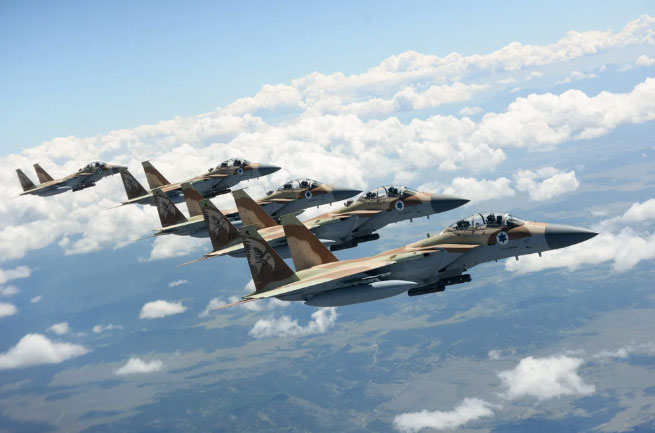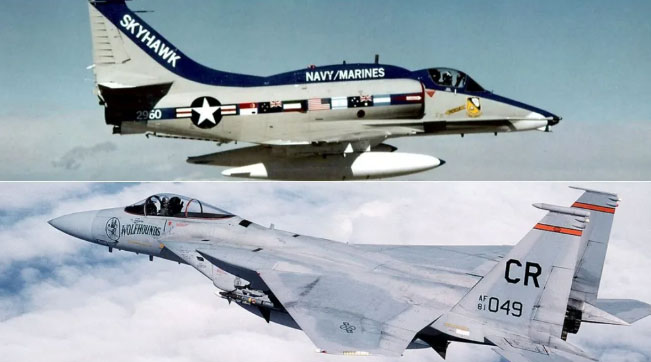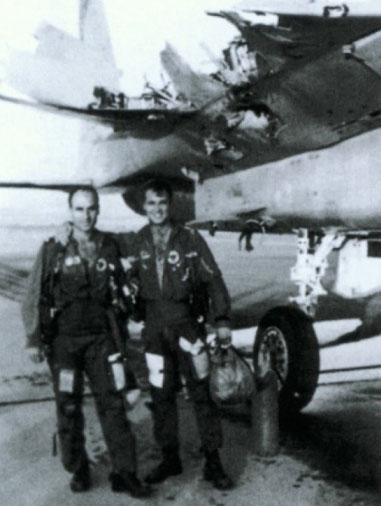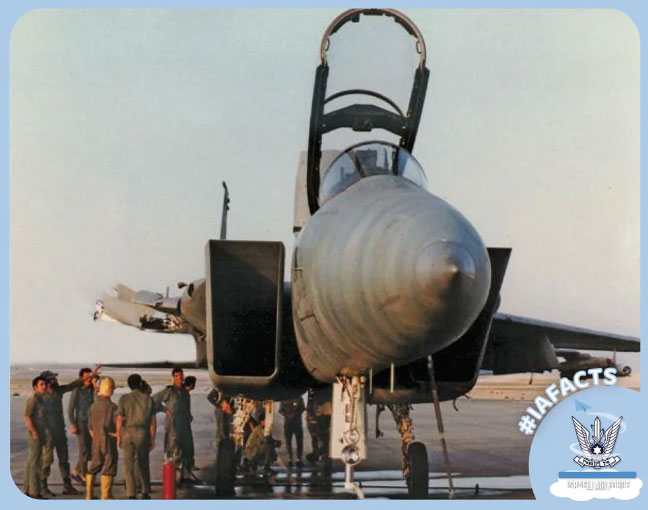As the A-4 Skyhawk pilot attempted to lock onto the F-15 fighter jet, he maneuvered and climbed without realizing that Nedivi’s “Eagle” was flying directly above him. And then…
According to military expert Alex Hollings from the reputable U.S. military information site Sandboxx, despite being introduced nearly half a century ago, the F-15 Eagle, manufactured by McDonnell Douglas, remains one of the most powerful air superiority fighters in the world today.
While the “Eagle” may not possess the advanced technologies of its fifth-generation successors, the F-22 Raptor and F-35 Joint Strike Fighter, it showcases formidable and exceptionally stable performance, to the extent that one pilot flying the F-15 managed to land safely after losing an entire wing.

F-15 fighter jet of the Israeli Air Force.
The Daring Escape of the F-15 Fighter Jet
On May 1, 1983, fighter squadrons from the 106th and 116th Air Wings of the Israeli Air Force took off for air combat training in the skies over the Negev Desert, featuring two F-15D jets engaging four older A-4N Skyhawks.
This was a “airfield defense” exercise, where the F-15s played a defensive role while the A-4s simulated attacking adversaries.
The A-4 Skyhawks at the time were outdated and posed little significant threat to the F-15s in a one-on-one scenario, but this time they had the advantage in numbers, and all the pilots were highly experienced experts.
One of the two F-15s was piloted by Zivi Nedivi, a trainee pilot in the front seat, under the guidance of instructor Yehoar Gal, an experienced F-15 pilot in the rear seat.
At that time, the F-15 was still relatively new, having just been inducted into the U.S. Air Force in 1976, and Israel had only recently received them. In fact, just a year prior, Nedivi had flown the F-15 and achieved the remarkable feat of shooting down four MiGs during the Lebanon War.
According to U.S. standards, pilots training for air combat were required to maintain a safe distance to create a “safety bubble,” with each aircraft at least 500 feet (152m) apart to avoid collisions during high-speed maneuvers in what pilots referred to as “Basic Air Combat Maneuvering.”

A-4 Skyhawk (top) and F-15 (bottom). (Illustrative image).
No aircraft was allowed to enter another’s “safety bubble,” and as the two Israeli Air Force F-15s were directed to intercept the A-4 adversaries, maintaining a safe distance was paramount.
Shortly before the A-4 Skyhawk and F-15 Eagle fighters engaged in combat in the sky, both sides were on high alert, seeking a decisive victory.
After a flawless maneuver, Skyhawk number 3, tail number 374, was ready to attack Nedivi’s teammate in another F-15.
The A-4 pilot was unaware of the situation; at that moment, Nedivi’s F-15, tail number Baz 957, had positioned itself from above and behind him, preparing to fire a simulated missile.
As the A-4 pilot attempted to lock onto the F-15, he maneuvered and began climbing, unaware that Nedivi’s “Eagle” was flying directly above him at that moment.
Thus, the two fighter jets collided. The A-4 struck the right side of the F-15 where the wing connects to the fuselage. The A-4 immediately separated after the collision, allowing the pilot enough time to safely eject.
Meanwhile, the F-15 lost its entire right wing and immediately entered a spin, plummeting downward. As Nedivi struggled to regain control of the aircraft, his instructor Gal urged him to prepare to eject as soon as the aircraft stabilized enough to do so. At that moment, no one was aware of the severe damage to their aircraft.
Nedivi recalled and explained: “I applied full power, which created drag as you spiral downward. Then the aircraft gradually stopped spinning, and I slowly pulled the nose back up.”
Eventually, the aircraft stabilized and became somewhat controllable, but Nedivi still did not fully comprehend the extent of the damage. When the F-15 leveled out, he and Gal looked to the right and saw fuel gushing from the wing root, creating a misty cloud.

Ziv Nedivi (left) and Yehoar Gal (right) in front of the wingless F-15. (Photo: IDF).
Due to the cloud of fuel pouring out, no one could see the hidden damage within. Nedivi tried to reduce speed, but once again the aircraft began to shake and spin. He suddenly spotted a runway 10 miles away and immediately made a decision.
He applied full power to both engines of the F-15 once more, knowing that this would deplete fuel more quickly, which could be considered a brave decision, but it was the only way to stabilize the aircraft and move in the right direction.
What both Nedivi and Gal did not know at that moment was that the aerial collision with the Skyhawk had severed the entire right wing of the F-15 down to the wing root (near the fuselage).
Just 10 miles (16km) felt like thousands, as the two pilots accomplished the impossible: They flew an F-15 with only one wing.
To keep the aircraft stable, Nedivi decided to maintain high speed, even though this made landing more difficult. He knew that the standard landing speed according to flight guidelines for the F-15 was 130 knots (234km/h), approximately 150 mph.
He tried to direct the aircraft toward the makeshift runway, hurtling down at nearly 260 knots (468km/h).
“I landed at a speed approximately twice the normal rate. I deployed the tailhook hoping it would help slow down, but it snapped off immediately.”
The F-15 sped down the runway and only came to a stop about 10 meters from an obstacle. When the aircraft finally halted, Nedivi turned to shake hands with Gal and realized the right side of the aircraft was gone. They had flown approximately 16 km on an F-15 with only one wing and landed safely.

The wingless F-15. (Photo: IDF).
F-15 Manufacturer Stunned, Even in Disbelief
McDonnell Douglas took great pride in the F-15’s extraordinary capabilities, but they were equally stunned and incredulous that the Israeli Air Force’s “Eagle,” despite having only one wing, managed to execute such a miraculous escape.
After receiving reports about the incredible flight, they dispatched a team of experts to Israel to inspect the F-15 and witness the miracle firsthand.
“Initially, these experts thought it was impossible; this was just an accident on the taxiway, it couldn’t happen in the air. It was only after they conducted a thorough analysis and concluded, OK, the F-15 has a very wide fuselage; if you fly fast enough, you act like a rocket. You don’t need wings,” Nedivi said.
After the accident, the fighter jet was transferred to a maintenance facility in Tel Nof, fitted with a new wing, and returned to service in the Israeli Air Force. Two years later, this F-15 went on to shoot down a Syrian MiG-23.





















































